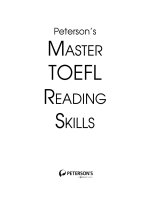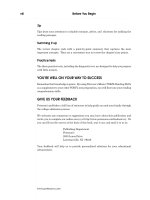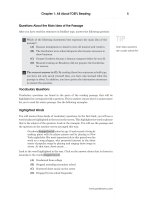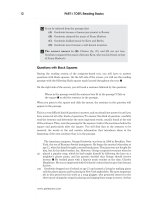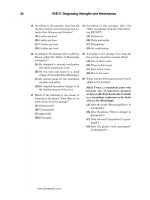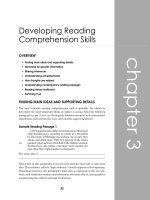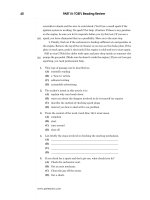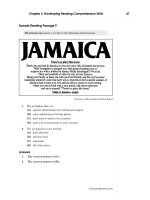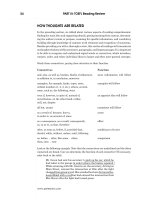Peterson’s master toefl reading skills part 14 pps
Bạn đang xem bản rút gọn của tài liệu. Xem và tải ngay bản đầy đủ của tài liệu tại đây (73.13 KB, 7 trang )
82 PART III: TOEFL Reading Review
www.petersons.com
3. The French and Indian War
(A) was quickly terminated
(B) caused great destruction among the French forces
(C) lasted eighteen years
(D) led to westward migration
4. The British made an agreement with the Native Americans to
(A) treat them fairly
(B) get the Indians’ land
(C) stop westward migration
(D) send Daniel Boone across the continent
5. The Indians sold their land
(A) for huge profits
(B) for a few trinkets
(C) because they didn’t understand the language
(D) because they believed it was infertile
6. At Little Big Horn River the Indians were
(A) defeated
(B) the victors
(C) forced to retreat
(D) massacred
7. The battle at Wounded Knee
(A) marks the end of the Indian wars
(B) occurred on the Indian reservation
(C) caused great hope among Native Americans
(D) was won by the Native Americans
8. Apparently, the author feels that the Bureau of Indian Affairs
(A) has been of great help to the Native Americans
(B) was established in the nineteenth century
(C) deprived the Native Americans
(D) has never done much for Native Americans
Answers
1. The correct answer is (D).
2. The correct answer is (B).
3. The correct answer is (C).
03_TOEFL Reading Ch 3,31-91 7/29/06, 12:0082
Chapter 3: Developing Reading Comprehension Skills 83
www.petersons.com
4. The correct answer is (C).
5. The correct answer is (B).
6. The correct answer is (B).
7. The correct answer is (A).
8. The correct answer is (D).
Sample Reading Passage 22
On July 4, 1776, a conclave of insurgent colonists in America passed the
Declaration of Independence. War against the British had already been going on
for over a year, so the Declaration came as the culmination of years of tempestuous
events in America.
The impetus for the American Revolution was the Treaty of Paris in 1763, which
ended the struggle between the British and the French for control over North
America. Since the colonists no longer were intimidated by the French, they ceased
to rely upon the British for protection and were not as submissive as they were
formerly. On the other hand, the British regarded the colonies as a source of
revenue and began to impose inequitable taxes upon them. The Sugar Act in 1764
and the Stamp Act in 1765 were so vehemently opposed by disgruntled colonists
that rioting broke out. The Stamp Act was repealed in 1766 as a result of the riots.
The British continued their policy of taxation without collaboration with their once
docile subjects. The Townshend Acts (a series of taxes on glass, lead, paper, and
tea) created such antipathy that the citizens of Boston attacked British soldiers
who fired upon them. That was the Boston Massacre of 1770. After the repeal of
the Townshend Acts, a new tea tax in 1773 again consolidated Boston residents’
dissension. About fifty men disguised as Indians boarded British ships and
jettisoned their cargo of tea in protest against the tea tax. That was the famous
Boston Tea Party. In reprisal, the British abolished the Bostonians’ right to self-
rule, and by passing what were referred to as Intolerable Acts in Boston, they
infuriated all of the colonies and caused them to unite in protest.
Representatives from twelve colonies gathered in Philadelphia in 1774 to plan a
stratagem to circumvent British interference in trade and to protest the infamy of
taxation without representation. The British responded that the colonies were in
rebellion, and, since nothing would appease either side, both sides prepared for war.
1. The author’s intent in this passage is to
(A) tell about the American Revolution
(B) describe the temperament of the colonists
(C) give the causes of the American Revolution
(D) describe the effects of the American Revolution
2. You may infer that the Treaty of Paris
(A) gave the French control of Canada
(B) gave the control of North America to the British
(C) made the colonists in America very angry
(D) had an immediate effect upon colonists’ desire for independence
(5)
(10)
(15)
(20)
(25)
03_TOEFL Reading Ch 3,31-91 7/29/06, 12:0083
84 PART III: TOEFL Reading Review
www.petersons.com
3. The colonists after the Treaty of Paris did not need the British because they
(A) were independent
(B) didn’t like to pay taxes
(C) didn’t need protection from an enemy
(D) made a treaty with the French
4. The Sugar Act and Stamp Act were
(A) passed in 1765
(B) taxes upon the colonists
(C) repealed
(D) equitable
5. The first violent protest against the British was made in
(A) 1764
(B) 1765
(C) 1770
(D) 1773
6. You can infer that in the Boston Massacre in 1770
(A) Boston was a battlefield
(B) Boston residents wanted independence
(C) colonists were killed
(D) British soldiers sided with Boston residents
7. The Boston Tea Party was
(A) a celebration in Boston
(B) an Indian rebellion
(C) held on board a British ship
(D) an act of aggression by the colonists
8. You can infer that the Intolerable Acts
(A) were repealed
(B) infringed upon colonists’ rights
(C) displeased the British
(D) were entirely related to taxes
9. You can infer that the meeting in Philadelphia in 1774
(A) was a very important social event
(B) took place to discuss taxes
(C) was a conclave of the British and the colonists
(D) was the first time the colonists united to protest British injustice
03_TOEFL Reading Ch 3,31-91 7/29/06, 12:0084
Chapter 3: Developing Reading Comprehension Skills 85
www.petersons.com
10. The British and the colonists went to war because the
(A) colonists wanted independence from their rulers
(B) British fired at the Bostonians in the Boston Massacre
(C) Bostonians dumped tea in the sea at the Boston Tea Party
(D) colonists objected to taxation without representation
Answers
1. The correct answer is (C).
2. The correct answer is (B).
3. The correct answer is (C).
4. The correct answer is (B).
5. The correct answer is (B).
6. The correct answer is (C).
7. The correct answer is (D).
8. The correct answer is (B).
9. The correct answer is (D).
10. The correct answer is (D).
Sample Reading Passage 23
The Titanic was the last “unsinkable” ship ever to set sail. Built in 1912 for the
British White Star Line, she was a colossal ship for the times—882 feet long,
46,328 tons, and capable of doing 25 knots an hour. Acclaimed as the zenith of
luxury liners, the ship had been fitted out with palatial accoutrements. Her
sixteen watertight compartments, her builders claimed, guaranteed that nothing
could sink her.
April 10, 1912, was a glittering occasion as the Titanic began her maiden voyage
from England to New York with 2,207 people on board, some of whom were
American tycoons whose estimated worth was over $250 million.
At 11:40 p.m. on April 14, many of the sleeping passengers were awakened by a
slight jolt. The ship had struck an iceberg, incurred a 300-foot gash in her side, and
five compartments were flooded. “Unsinkable,” however, meant the ship could
float if two, not five, compartments were inundated. Ten miles away from the
Titanic was another ship, the Californian, which had stopped because of ice fields
and which had wired six explicit warnings to nearby ships. Unfortunately, the
Titanic’s wireless, a new invention on shipboard, was being employed for frivolous
messages to and from the passengers. The tired wireless operator had worked long
hours and impatiently told the Californian’s operator to shut up and stop annoying
him.
By 12:05 a.m. officers and crew fully comprehended that something was seriously
amiss. Lifeboats were uncovered, and passengers and crew were mustered to the
boat deck. Ten minutes later a “CQD” sent out to summon help was received by
ships too distant to be of immediate help. The Californian might as well have been
in the South Seas for all the assistance she ever gave. Her wireless operator,
(5)
(10)
(15)
(20)
03_TOEFL Reading Ch 3,31-91 7/29/06, 12:0085
86 PART III: TOEFL Reading Review
www.petersons.com
unfamiliar with the new equipment, had failed to wind up the mechanism that
kept the set running. At about 11:40 he tuned in, heard nothing from his dead set,
and went to bed.
Secure in the knowledge that their ship was unsinkable, the White Star Line had
provided enough lifeboat space for only 1,178 people. There were sixteen wooden
lifeboats and four collapsible canvas boats on board for 2,207 people. The crew’s
efforts to load the lifeboats in the midst of chaos and bitterly cold weather were
heroic but disorganized. Women and children were supposed to be first in the
lifeboats, but no matter how chivalrous the men, the women were querulous about
leaving the ship for a cold, open boat and had to be cajoled into the boats. At 12:45
the Californian crew watched the Titanic’s rockets overhead and regarded them
as “strange.” The first boat was being lowered into the icy sea at the same moment;
with a capacity for forty, it contained twelve. Throughout the fiasco of lifeboat
loading, the ship’s orchestra played ragtime, the lights blazed, and the Titanic
continued to slip downward at the bow.
Meanwhile, three ships had received an SOS, the first time that signal had ever
been used, and they were confused. All had been advised that the Titanic was
sinking. The Carpathia was fifty-eight miles away. The Californian watched the
last rocket go off at 1:40. At 2:05 the last boat was lowered as the band played an
Episcopal hymn, “Autumn,” not “Abide with Me,” as is usually believed. With the
ship standing at a 90° angle, perpendicular in the water, at 2:10 the last SOS was
sent out. At 2:20 A.M. on April 15, 1912, the Titanic sank. The crew of the
Californian believed that the disappearing lights indicated that the ship was
leaving the area.
At 4:10 the Carpathia was the first ship to reach the scene. The Californian
arrived at 5:40, too late to rescue any survivors. From eighteen boats 705 people
were rescued. Following inquiries regarding the disaster, it was revealed that very
few of the third-class passengers had been saved. Of 143 women in first class, 4
were lost; of 93 women in second class, 15 were lost; of 179 women in third class,
81 were lost. All but one child in first and second class were saved, but of the 76
children in third class, only 23 survived.
1. You can infer that “the Titanic was the last ‘unsinkable’ ship” means that
(A) the Titanic was not unsinkable
(B) the Titanic would not have sunk if only two compartments had
been flooded
(C) nobody ever believed in an “unsinkable” ship after the Titanic
disaster
(D) nobody ever built a ship like the Titanic again
2. You can infer from the statistics regarding the number of third-class
passengers who survived that
(A) they did not know the ship was sinking
(B) they ignored the crew’s calls to the lifeboats
(C) they courteously allowed the first- and second-class passengers to
leave the ship first
(D) there was class distinction in the filling of the lifeboats
(25)
(30)
(35)
(40)
(45)
(50)
(55)
03_TOEFL Reading Ch 3,31-91 7/29/06, 12:0086
Chapter 3: Developing Reading Comprehension Skills 87
www.petersons.com
3. You can infer that the Californian crew
(A) callously ignored the Titanic’s plight
(B) could have saved many if it had heeded the rockets
(C) didn’t want to lose any sleep
(D) did its best to aid the Titanic
4. You can infer that many of the Titanic’s male passengers
(A) succumbed quickly in the icy sea
(B) were frivolous
(C) saved themselves instead of the women and children
(D) were very rich
5. The first SOS signal was called
(A) a wireless
(B) a warning
(C) CQD
(D) a message
Answers
1. The correct answer is (C).
2. The correct answer is (B).
3. The correct answer is (D).
4. The correct answer is (A).
5. The correct answer is (C).
03_TOEFL Reading Ch 3,31-91 7/29/06, 12:0087
88 PART III: TOEFL Reading Review
www.petersons.com
EXERCISES: READING HISTORY TEXTBOOKS
Directions: The passages below are followed by questions based on their content.
Answer the questions on the basis of what is stated or implied in the passages.
QUESTIONS 1–7 ARE BASED ON THE
FOLLOWING PASSAGE.
When Franklin D. Roosevelt was
elected President of the United States in
1932, not only the United States but also
the rest of the world was in the throes of
an economic depression. Following the
termination of World War I, Britain and
the United States at first experienced a
boom in industry. Called the Roaring
Twenties, the 1920s ushered in a num-
ber of things—prosperity, greater equal-
ity for women in the work world, rising
consumption, and easy credit. The out-
look for American business was rosy.
October 1929 was a month that had
catastrophic economic reverberations
worldwide. The American stock market
witnessed the “Great Crash,” as it is
called, and the temporary boom in the
American economy came to a standstill.
Stock prices sank, and panic spread.
The ensuing unemployment figure
soared to 12 million by 1932.
Germany in the postwar years suf-
fered from extreme deprivation because
of onerous reparations it was obliged to
pay to the Allies. The country’s indus-
trial capacity had been greatly dimin-
ished by the war. Inflation, political
instability, and high unemployment
were factors conducive to the growth of
the embryonic Nazi party. Germans
had lost confidence in their old leaders
and heralded the arrival of a figure who
would lead them out of their economic
wilderness.
Roosevelt was elected because he prom-
ised a “New Deal” to lift the United
States out of the doldrums of the depres-
sion. Following the principles advocated
by Keynes, a British economist,
Roosevelt mustered the spending ca-
pacities of the federal government to
provide welfare, work, and agricultural
aid to the millions of down-and-out
Americans. Elected President for four
terms because of his innovative policies,
Roosevelt succeeded in dragging the
nation out of the Depression before the
outbreak of World War II.
1. A good title for this selection would be
(A) The Twenties
(B) The End of World War I
(C) The Great Crash
(D) The Depression
2. The 1920s were called the Roaring Twen-
ties because
(A) social and economic affairs were
prospering
(B) women were advancing in the fight
for equal rights
(C) there was little unemployment
(D) people were celebrating the end of
World War I
3. When Roosevelt was elected,
(A) the nation was in a deep depression
(B) there were 12 million unemployed
workers
(C) the nation needed help from the fed-
eral government
(D) All of the above.
4. The “Great Crash” refers to
(A) the end of World War I
(B) the Great Depression
(C) a slump in the stock market
(D) high unemployment figures
(5)
(10)
(15)
(20)
(25)
(30)
(35)
(40)
(45)
03_TOEFL Reading Ch 3,31-91 7/29/06, 12:0088
